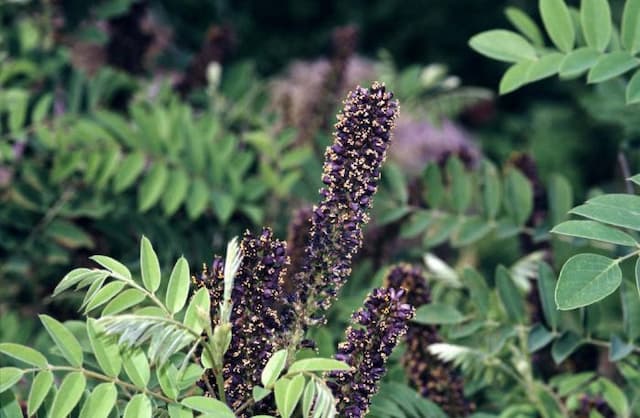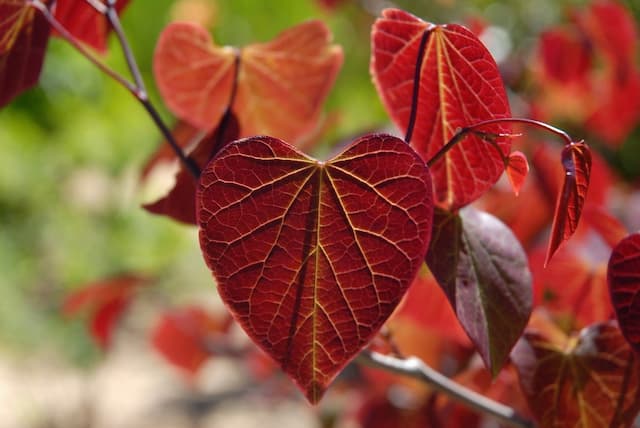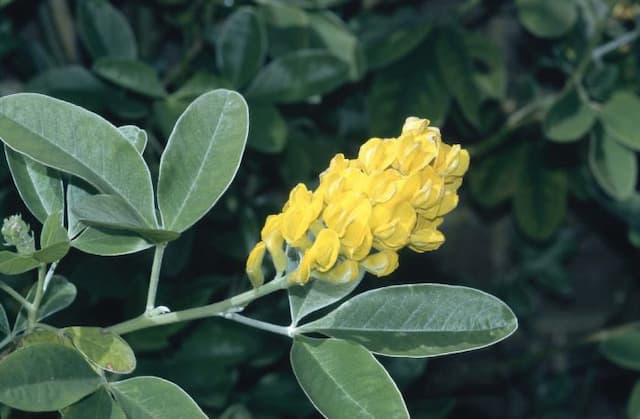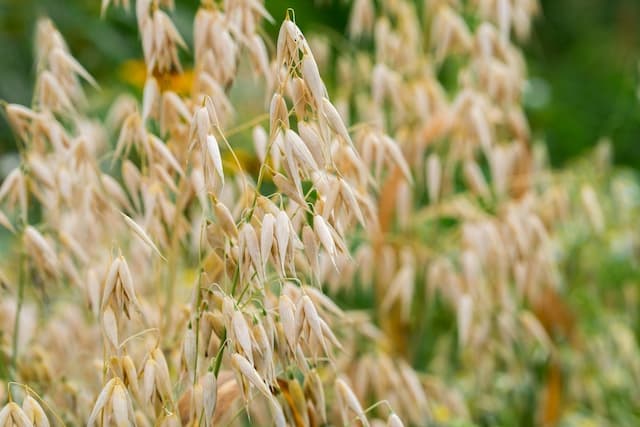Mountain kidney vetch 'Rubra' Anthyllis montana 'Rubra'

ABOUT
'Rubra' is a woody-based perennial forming a spreading clump to 30cm in height, with silky leaves divided into many small leaflets, and clover-like heads of small, bright crimson flowers in late spring and early summer
About this plant
 Names
NamesFamily
Fabaceae
Synonyms
Red Mountain Kidney Vetch, Red Kidney Vetch, Ruby Kidney Vetch
Common names
Anthyllis montana 'Rubra'
 Characteristics
CharacteristicsLife cycle
Perennials
Foliage type
Deciduous
Color of leaves
Green
Flower color
Red
Height
1 foot (0.3 meters)
Spread
1 foot (0.3 meters)
Plant type
Herb
Hardiness zones
5
Native area
Europe
Benefits
 General Benefits
General Benefits- Attracts Pollinators: The blossoms of Anthyllis montana 'Rubra', commonly known as red kidney vetch, attract bees and other pollinating insects, which are vital for the health of ecosystems.
- Drought Tolerant: It's well-suited to xeriscaping and low-water gardens due to its ability to withstand periods of drought once established.
- Soil Stability: This plant is effective in stabilizing soil and preventing erosion, especially on slopes and in rocky areas.
- Aesthetic Appeal: With its vibrant red flowers, red kidney vetch adds color and visual interest to rock gardens, borders, and alpine gardens.
- Low Maintenance: It is known for being a low-maintenance plant, requiring minimal attention once it has settled into its environment.
- Wildlife Support: Red kidney vetch can provide habitat and food for various species of wildlife, particularly insects and small birds.
- Adaptability: It adapts well to a variety of soil types, although it prefers well-drained soils.
- Herbaceous Perennial: As a perennial, it returns each year, providing long-term landscape presence and reducing the need for annual replanting.
 Medical Properties
Medical PropertiesThis plant is not used for medical purposes.
 Air-purifying Qualities
Air-purifying QualitiesThis plant is not specifically known for air purifying qualities.
 Other Uses
Other Uses- As an ornamental ground cover in rock gardens or alpine gardens, the low-growing plant can add vibrant red coloration and texture.
- In butterfly gardens, Anthyllis montana 'Rubra' can provide a nectar source for various butterfly species during its flowering period.
- Due to its nitrogen-fixing abilities, it can be used in permaculture designs to enrich soil quality over time.
- It's useful for stabilizing slopes or banks to prevent soil erosion because of its rooting system.
- In landscape design, it serves as a colorful edging plant along paths or garden borders.
- The plant can be used in crafting natural dyes for fabrics or other materials using its blossoms, which produce a range of red and pink hues.
- It can serve as a living mulch, suppressing weeds while retaining soil moisture in garden beds.
- As part of xeriscaping, Anthyllis montana 'Rubra' is well-suited to drought-resistant gardens due to its low water requirements once established.
- The woolly texture of the leaves can be interesting in sensory gardens, where tactile experiences with plants are a focus.
- Plant enthusiasts may use Anthyllis montana 'Rubra' in botanical illustrations and photography due to its striking appearance.
Interesting Facts
 Feng Shui
Feng ShuiThe plant Kidney Vetch is not used in Feng Shui practice.
 Zodiac Sign Compitability
Zodiac Sign CompitabilityThe plant Kidney Vetch is not used in astrology practice.
 Plant Symbolism
Plant Symbolism- Protection: Anthyllis montana 'Rubra', commonly known as Mountain Kidney Vetch, has been traditionally believed to offer protection against harm and negative influences.
- Restoration: Its healing properties, especially in traditional medicine, symbolize the plant's capacity to restore and rejuvenate the body and spirit.
- Hardiness: The ability of Mountain Kidney Vetch to thrive in challenging mountainous terrains symbolizes resilience and the power to overcome adversity.
- Love: The vibrant red color of its flowers is often associated with passion and deep love, making it a symbol of strong emotional bonds.
- Beauty and Elegance: With its delicate and attractive blossoms, Mountain Kidney Vetch is symbolic of natural beauty and gracefulness in its environment.
 Water
WaterMountain kidney vetch should be watered moderately, allowing the soil to dry out slightly between waterings. Typically, this translates into watering once every week or two, depending on the climate and season, using about half a gallon of water for outdoor plants. For potted plants, adjust the amount to roughly 16 ounces per watering to prevent waterlogging. During hot, dry periods, you may need to water more frequently, but always check the soil moisture before adding more water. Over-watering can lead to root rot, so it's vital to ensure good drainage and avoid letting the plant sit in water.
 Light
LightMountain kidney vetch thrives best in full sun to partial shade. Ideally, place the plant in a spot where it receives at least six hours of direct sunlight each day. The bright light will help the plant produce its characteristic red flowers and maintain healthy growth. However, in regions with very intense sunlight, a location with afternoon shade can prevent possible scorching of the foliage.
 Temperature
TemperatureMountain kidney vetch is hardy and can tolerate temperatures down to about 10°F, but it grows best in cooler climates with temperatures ranging from 50 to 75°F. It's important to protect the plant from extreme heat, so in regions where temperatures rise above 85°F, providing some afternoon shade can help mitigate heat stress. Winter hardiness is one of this plant's strengths, allowing it to survive temperatures well below freezing.
 Pruning
PruningPruning mountain kidney vetch is important to maintain its shape and encourage denser growth. Prune after flowering by cutting back the spent flower stems and about a third of the plant's overall height. This should be done annually, typically in late summer or early fall. Pruning at this time helps to stimulate new growth and results in a more compact, bushy plant the following season.
 Cleaning
CleaningAs needed
 Soil
SoilMountain Kidney Vetch prefers well-draining soil mixed with sand and gravel to mimic its native alpine conditions, with a pH ranging from neutral to slightly alkaline.
 Repotting
RepottingMountain Kidney Vetch does not require frequent repotting; it should be done every 2-3 years to refresh the soil or if the plant has outgrown its current pot.
 Humidity & Misting
Humidity & MistingMountain Kidney Vetch thrives in average to low humidity conditions and does not require specific humidity adjustments.
 Suitable locations
Suitable locationsIndoor
Ensure bright light, cool temps, and well-drained soil for Mountain Kidney Vetch.
Outdoor
Plant in full sun with well-draining soil for Mountain Kidney Vetch.
Hardiness zone
4-8 USDA
 Life cycle
Life cycleThe life cycle of Anthyllis montana 'Rubra', commonly known as Red Kidney Vetch, begins with seed germination in spring, requiring stratification or a period of cold to break dormancy. Seedlings establish their root systems and produce a rosette of leaves close to the ground. As the plant matures, it develops flowering stems in late spring to early summer, showcasing its characteristic reddish-purple flowers that attract pollinators. After pollination, flowers give way to seed pods that mature by late summer. The plant then enters a period of dormancy during fall and winter, with the foliage dying back in colder climates. Red Kidney Vetch is a perennial, so it regrows from the same root system each year, completing its life cycle.
 Propogation
PropogationPropogation time
Spring-Early Summer
The most popular method of propagation for the Kidney Vetch (Anthyllis montana 'Rubra') is through seed sowing. This is typically done in late winter to early spring. The seeds should be sown in well-draining soil and lightly covered with soil, ideally no more than a quarter of an inch (about 6 millimeters). The flats or pots containing the seeds should be kept moist but not waterlogged, and placed in a warm area with plenty of indirect sunlight. Germination usually occurs within two to four weeks. Once the seedlings have grown enough to handle, they can be transplanted into individual pots or the garden. Kidney Vetch prefers well-drained soil and a sunny location and can be an excellent addition to rock gardens or borders.









